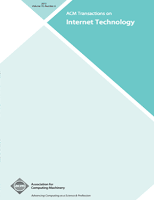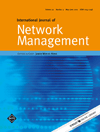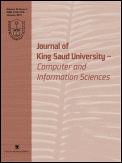
ACM Transactions on Internet Technology
Scope & Guideline
Exploring Innovations in Digital Connectivity
Introduction
Aims and Scopes
- Internet of Things (IoT):
Research related to the architecture, protocols, and applications of IoT systems, emphasizing security, privacy, and real-time data processing. - Edge and Fog Computing:
Studies on distributed computing paradigms that bring computation and data storage closer to the data source, enabling low-latency processing and improved resource management. - Cybersecurity and Privacy:
Exploration of methods and frameworks to secure Internet applications and protect user privacy, including blockchain technology and privacy-preserving algorithms. - Machine Learning and AI Applications:
Integration of machine learning and artificial intelligence in Internet technologies, focusing on intelligent data processing, predictive analytics, and automated decision-making. - Smart Cities and Urban Computing:
Research on utilizing Internet technologies to enhance urban living, including smart transportation systems, energy management, and citizen engagement. - Blockchain and Decentralized Systems:
Investigations into blockchain technology applications, including trust management, decentralized finance, and secure data sharing. - Network Protocols and Architectures:
Development and analysis of protocols and architectures that facilitate efficient communication and data exchange across diverse networks.
Trending and Emerging
- Federated Learning and Privacy-preserving Techniques:
Increasingly, research is focusing on federated learning methods that allow for collaborative model training without compromising data privacy, catering to the growing demand for secure AI applications. - Smart and Connected Health Solutions:
There is a notable rise in studies related to health technology, particularly those leveraging IoT and AI for remote patient monitoring and telehealth services. - Cyber-Physical Systems:
Research on cyber-physical systems, which integrate computation with physical processes, is becoming more prominent, addressing challenges in automation and real-time processing. - AI-Driven Automation and Optimization:
The application of AI for optimizing resource allocation, network management, and service delivery in real-time environments is gaining traction among researchers. - Sustainable and Green Computing:
Emerging themes around sustainability in Internet technologies reflect a growing concern for energy-efficient computing solutions and environmentally friendly practices. - Decentralization and Blockchain Innovations:
The exploration of new blockchain applications beyond cryptocurrency, such as in supply chain management and digital identity verification, is rapidly increasing.
Declining or Waning
- Traditional Web Technologies:
Research focusing on older web technologies and standards has decreased, as the focus shifts towards more modern frameworks and real-time applications. - Legacy Systems Integration:
Studies aimed at integrating legacy systems with contemporary Internet technologies are becoming less common, possibly due to the increasing push for cloud-native and microservices architectures. - Basic Network Management:
Publications on fundamental network management practices are declining, overshadowed by advanced topics like SDN (Software Defined Networking) and network automation. - Static Security Models:
Research on static security models that do not adapt to evolving threats is losing traction, as there is a growing need for dynamic and adaptive security solutions. - Conventional Data Mining Techniques:
Interest in traditional data mining approaches is waning, replaced by a stronger focus on machine learning and AI-driven methodologies that offer more robust analytical capabilities.
Similar Journals

Service Oriented Computing and Applications
Pioneering Insights in Service ComputingService Oriented Computing and Applications is an esteemed journal published by SPRINGERNATURE, focusing on the rapidly evolving domains of service-oriented computing and its myriad applications. With an ISSN of 1863-2386 and an E-ISSN of 1863-2394, this journal has an impressive track record since its inception in 2007, converging with significant contributions from researchers and professionals through 2024. This journal stands out in the academic landscape, evidenced by its categorization in Q2 across multiple fields, including Hardware and Architecture, Information Systems, Management Information Systems, and Software, as per the latest 2023 metrics. Although it does not currently offer Open Access options, its relevance in Computer Science, Business Management, and integrated technology makes it a valuable resource for scholars and practitioners alike, aiming to explore the intersection of computing technologies and their application in real-world scenarios. The journal's rankings in Scopus provide further testament to its impact and importance, making it a key publication for anyone looking to stay at the forefront of advancements in service-oriented computing.

IEEE Internet of Things Journal
Leading the Charge in IoT Research and DevelopmentWelcome to the IEEE Internet of Things Journal, a leading publication in the field of connected systems and smart technologies. Published by the IEEE - Institute of Electrical and Electronics Engineers Inc, this journal is dedicated to disseminating cutting-edge research and innovative developments in the Internet of Things (IoT) domain. With an impressive impact factor and recognized as a Q1 journal across multiple categories such as Computer Networks and Communications, Information Systems, and Signal Processing, the IEEE Internet of Things Journal serves as an essential resource for researchers, industry professionals, and students looking to advance their knowledge and contribute to this rapidly evolving field. Since its inception in 2014, the journal has steadily risen to prominence, ranking impressively in Scopus metrics with top positions in key categories, ensuring high visibility and credibility in the academic community. We invite you to explore the rich array of articles and access options available to support your research endeavors in one of the most transformative areas of technology today.

International Journal of Network Management
Elevating Standards in Network Management Scholarship.The International Journal of Network Management, published by WILEY, has been an authoritative resource in the field of network management since its inception in 1991. With a strong academic reputation reflected in its 2023 category quartiles placing it in Q2 for both Computer Networks and Communications and Computer Science Applications, this journal is ranked within the top tiers of its categories, underscoring its pivotal role in disseminating high-quality research. The journal aims to provide insights into the latest advancements in network management strategies, technologies, and applications, catering to the needs of researchers, professionals, and students alike. By embracing rigorous peer-review processes and a commitment to publishing cutting-edge studies, it serves as a crucial platform for the exchange of knowledge and innovation within the network management community. Explore the wealth of resources and join the dialogue among a diverse audience striving to shape the future of computer networks and applications.

International Journal of Networked and Distributed Computing
Unveiling the Future of Distributed IntelligenceWelcome to the International Journal of Networked and Distributed Computing, published by SpringerNature, a premier outlet for cutting-edge research in the realms of computer networks and distributed computing systems. Established as an Open Access journal since 2013 and based in the Netherlands, this publication strives to disseminate high-quality, peer-reviewed studies that address the complexities of contemporary computing challenges. With an impact factor that reflects its growing influence—positioned in the Q3 category for both Computer Networks and Communications and Computer Science Applications—this journal serves as a pivotal resource for scholars and practitioners aiming to advance knowledge and innovation in this rapidly evolving field. The journal encompasses diverse topics, from network protocols to distributed algorithms, ensuring that researchers, professionals, and students can find relevant insights and methodologies to inform their work. Join us in exploring the depths of networked and distributed computing, contributing to a collaborative academic environment that shapes the future of technology.

Internet Technology Letters
Connecting Academia and Industry Through Cutting-edge Research.Internet Technology Letters, published by John Wiley & Sons Ltd, is a dynamic and rapidly evolving journal that focuses on the innovative applications and developments within the realms of Artificial Intelligence, Computer Networks and Communications, Information Systems, and Software. With its E-ISSN 2476-1508 and a defined convergence period from 2018 to 2024, this journal seeks to address emerging trends and critical challenges confronting the digital landscape today. Recognized in the Q3 quartile range across multiple computer science categories in 2023, it serves as a valuable resource for researchers, professionals, and students seeking to advance their knowledge and stay updated on significant technological advancements. While currently not an open-access journal, Internet Technology Letters holds a prominent position on platforms like Scopus, ranked within the middle percentiles, reflecting its contribution to the academic community. The journal aims to foster connectivity between academia and industry, encouraging submissions that promote interdisciplinary collaboration and innovation. By creating a platform for sharing groundbreaking research, Internet Technology Letters plays a crucial role in shaping future technological landscapes.

International Journal of Grid and Utility Computing
Pioneering Innovations in Grid and Utility ComputingInternational Journal of Grid and Utility Computing is a pioneering publication dedicated to advancing research in the domains of grid computing, utility computing, and their applications across various sectors. Initiated in 2005 and continuing through 2024, the journal is published by INDERSCIENCE ENTERPRISES LTD, a respected publisher known for its commitment to facilitating scholarly communication. With an ISSN of 1741-847X and an E-ISSN of 1741-8488, this journal, based in the United Kingdom, serves a global audience of researchers, professionals, and students. Although classified in the Q4 category across Applied Mathematics, Computer Science Applications, and Management Information Systems, the journal aims to bridge theoretical research with practical implementation, fostering interdisciplinary collaborations. Researchers looking for a platform to disseminate their work on grid technology and its utility in modern computing environments will find this journal an invaluable resource. The focus on innovative computing methodologies places it at the forefront of emerging trends and technology applications, despite the need for increased visibility in competitive metrics like Scopus rankings.

Future Generation Computer Systems-The International Journal of eScience
Elevating Knowledge in Computer Networks and BeyondFuture Generation Computer Systems - The International Journal of eScience, published by ELSEVIER, stands at the forefront of the fields of computer networks, hardware architecture, and software engineering, as evidenced by its impressive Q1 quartile rankings in 2023 across these categories. With an ISSN of 0167-739X and an E-ISSN of 1872-7115, this esteemed journal has been a significant contributor to the body of knowledge in the computer science domain since its inception in 1984, continuing to shape the landscape of eScience through cutting-edge research and innovative practices. Featuring a broad scope that embraces various interrelated disciplines, Future Generation Computer Systems is particularly recognized for its high impact factor and prestigious Scopus rankings, where it ranks in the top echelons—8th in Computer Networks and Communications, 5th in Hardware and Architecture, and 17th in Software—placing it in the 95th to 98th percentiles of their respective fields. Although currently not open access, the journal provides invaluable insights and advancements aimed at researchers, professionals, and students alike, driving the evolution of technology and its applications in an increasingly digital world.

Annals of Telecommunications
Unveiling the latest trends in telecommunications engineering.Annals of Telecommunications is a prestigious peer-reviewed journal published by SPRINGER INT PUBL AG, dedicated to advancing the field of electrical and electronic engineering. Established in 1946, this journal presents a comprehensive collection of research articles that address the latest trends and developments in telecommunications, including innovative technologies, systems, and applications. With an impressive Q2 ranking in the 2023 category of Electrical and Electronic Engineering and a Scopus rank in the 68th percentile, the journal serves as a vital platform for researchers, professionals, and students looking to disseminate groundbreaking findings and engage with contemporary challenges in the field. Although it is not an Open Access journal, it offers a wealth of knowledge that contributes to both academic and practical advancements in telecommunications. The Annals of Telecommunications remains an essential resource for anyone involved in telecommunication research and practice, fostering collaboration and knowledge exchange globally.

Journal of King Saud University-Computer and Information Sciences
Connecting Ideas, Shaping the Future of TechnologyJournal of King Saud University-Computer and Information Sciences, published by ELSEVIER, is a prestigious open-access journal focusing on the rapidly evolving fields of computer science and information technology. Since its inception in 1996, this journal has provided a platform for high-quality research and innovative ideas, promoting the dissemination of knowledge to a global audience. With a remarkable impact factor and ranked Q1 in the Computer Science (miscellaneous) category as of 2023, it stands among the top 11% of journals in its field, reflecting its commitment to excellence and relevance. The journal proudly carries the ISSN 1319-1578 and E-ISSN 2213-1248, and it is based in Saudi Arabia while being part of a global academic network. With a Scopus rank of #26 out of 232 in general computer science, the Journal of King Saud University-Computer and Information Sciences is an essential resource for researchers, professionals, and students seeking to stay at the forefront of technological advancement. As it continues to thrive through 2024, it invites contributions that will shape the future of computing and information sciences.

Journal of Information Technology Research
Connecting Scholars to the Pulse of IT InnovationJournal of Information Technology Research (ISSN: 1938-7857, E-ISSN: 1938-7865) is a prestigious academic journal published by IGI Global, dedicated to advancing the field of information technology through rigorous research and insightful analysis. This journal serves as a critical platform for scholars, professionals, and students alike, providing them with up-to-date knowledge and innovative solutions in the ever-evolving realm of computer science. Despite the coverage of the journal being discontinued in Scopus after 2020, it previously held a commendable rank of #145 out of 221 in the 'General Computer Science' category, placing it in the 34th percentile, which reflects its respectable standing among peers. Although currently not an Open Access journal, its contributions significantly shape the discourse surrounding emerging technologies, information systems, and IT management.